February 6, 2015
Air Date: February 6, 2015
FULL SHOW
SEGMENTS
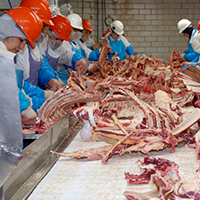
New Agency Proposed To End Food Safety Problems
View the page for this story
Millions of Americans are sickened every year by eating tainted food, but decades of federal effort to prevent such illnesses have resulted in a fragmented and inconsistent regulation system. Host Steve Curwood speaks with Caroline Smith DaWaal, Food Safety Director for the Center for Science in the Public Interest, about how a single food safety agency could solve the problem and bring effective management under one roof. (06:40)

Bi-Partisan Call for a Gasoline Tax
View the page for this story
Bob Inglis, a former Republican Congressman from South Carolina, says that low oil prices mean politicians on both sides of the aisle are talking about raising the gasoline tax, which would help the climate and fund highways. (07:45)

Beyond the Headlines
/ Peter DykstraView the page for this story
In this week’s trip beyond the headlines, Peter Dykstra and host Steve Curwood discuss the volatile US energy market and the fiftieth anniversary of President Lyndon B. Johnson’s message to Congress that laid out environmental issues still of concern today. (04:30)
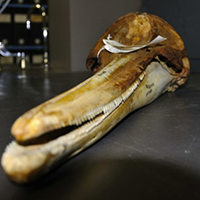
Probing Dolphins’ Genetic Mysteries
/ Matthew S. LeslieView the page for this story
Dolphins famously save people from drowning, but we still used to kill them by the millions, often as by-catch in tuna fishing nets. A huge collection of tissue from these inadvertently caught mammals is now helping unravel dolphins’ genetic secrets, as Matthew Leslie reports from the Scripps Institution of Oceanography in La Jolla. (05:40)
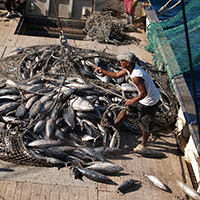
Eyes on the Seas
View the page for this story
In recent years large tracts of ocean have been protected from commercial fishing and other forms of extraction. And Josh Reichert of the Pew Charitable Trusts, says that his organization has developed new technology to help governments around the world enforce their fishing bans in marine protected areas. (07:30)
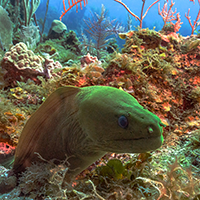
Cuba's Unspoiled Tropical Reefs
View the page for this story
Cuban reefs are some of the most beautiful and well-preserved in the world, partly due to the country’s economic isolation. But with relations between the US and Cuba thawing, diver and photographer Robert Wintner had the chance to dive Cuba’s unspoilt reefs and has detailed the experience in his new book Reef Libre: The Last, Best Reefs in the World, which he discussed with host Steve Curwood. (15:00)
Show Credits and Funders
Show Transcript
HOST: Steve Curwood
GUESTS: Caroline Smith DeWaal, Bob Inglis, Joshua Reichert, Robert Wintner
REPORTERS: Peter Dykstra, Matthew Leslie
[THEME]
CURWOOD: From Public Radio International, this is Living on Earth.
[THEME]
CURWOOD: I'm Steve Curwood. Many Republicans question the science of global warming, but some say a Presidential candidate who embraces free-market climate solutions could have a winning strategy for the GOP.
INGLIS: I think there’s an incredible breakthrough opportunity for a candidate that wants to lead the Grand Opportunity Party and leave behind the Grumpy Old Party if they embrace the science of climate and say, “You know what? Free-enterprise has an answer to this.”
CURWOOD: Also, before there were rules to ensure safer fishing techniques, millions of dolphins were caught and killed in commercial fishing nets.
CHIVERS: It is moving for people to see, when you realize that the jaws of over 40,000 dolphins are here on these shelves. It does kind of bring it home to you about how many dolphins were actually killed.
CURWOOD: That and more this week on Living on Earth. Stick around.
[NEWSBREAK MUSIC: Boards Of Canada “Zoetrope” from “In A Beautiful Place Out In The Country” (Warp Records 2000)]
ANNOUNCER: Support for Living on Earth comes from United Technologies – innovating to make the world a better, more sustainable, place to live.
New Agency Proposed To End Food Safety Problems
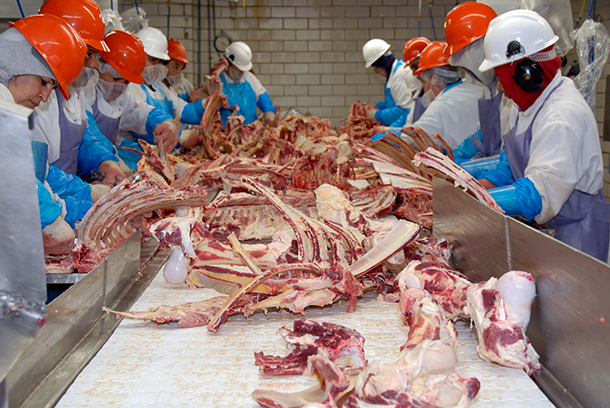
The USDA’s Food Safety and Inspection Service (FSIS) inspectors ensure that beef is processed in accordance with USDA FSIS regulations. They inspect meat at processing plants everyday. (Photo: Alice Welch/USDA)
CURWOOD: From the Jennifer and Ted Stanley Studios in Boston and PRI, this is Living on Earth. I’m Steve Curwood. Millions of Americans are sickened every year by what they eat – by contaminated food, adulterated food, and food laden with germs. Thousands are hospitalized, and hundreds die. Yet the US has robust government agencies pledged to keep us safe. Perhaps too many agencies with different standards – and that’s why some members of Congress are calling for the creation of a single agency to regulate food safety, and President Obama has endorsed the concept by putting it in his recent budget proposal. Caroline Smith DeWaal is the Food Safety Director for the Center for Science in the Public Interest in Washington, and we turn to her for some perspective. Welcome to Living on Earth.
DEWAAL: Thanks so much for having me, Steve. I'm happy to be here.
CURWOOD: Now, as I understand it, there's been a bill proposed to create a single federal food safety agency and President Obama has also put forward in his budget proposal the creation of a single federal food safety agency. How effective do you think this will be in addressing the problem?
DEWAAL: Food safety was really designed as a government program in 1906, and while there have been a couple of efforts to modernize it, we have food safety responsibilities spread out all over the federal government. We have some food products regulated by the US Department of Agriculture, others are regulated at the Food and Drug Administration, pesticides are covered over at the Environmental Protection Agency, and altogether we have about 15 federal agencies that play some role in food regulation in the US, so it would really make a lot of sense to tie these programs together, and so that the agency...the new agency's really working on the same model for determining when plants should be inspected, when pathogens are considered adulterants and when food should be recalled. These are the kind of responsibilities that are not being handled well with the current structure of food safety oversight.
CURWOOD: So the President has called for a single food federal safety agency in his budget, there’s the bill on Capitol Hill. How would this agency function? Under whom would it be?
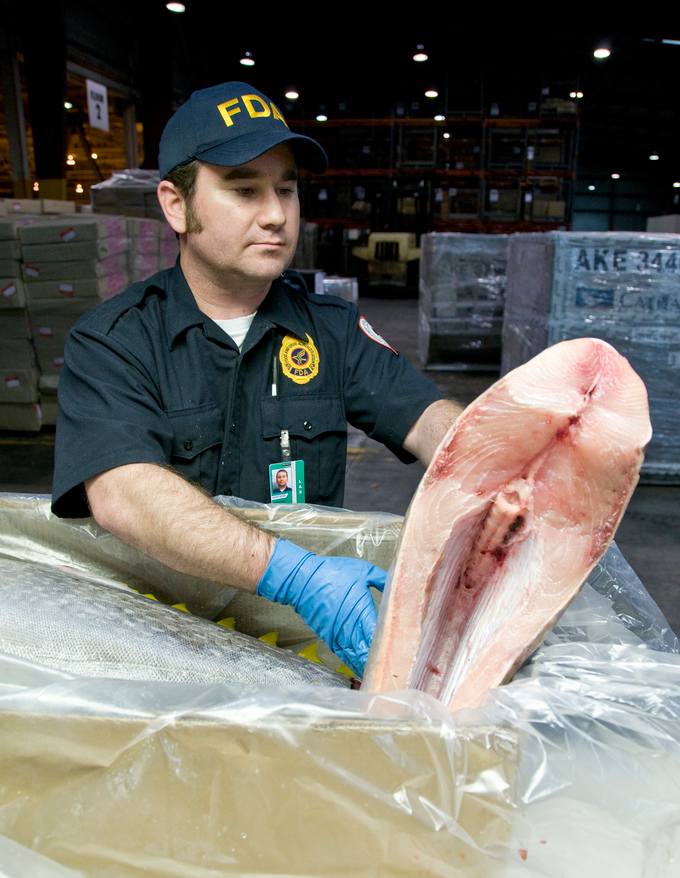
FDA field inspectors check shipments of imported seafood using sight, touch, and smell to determine freshness. They also take samples to the lab for testing. (Photo: Michael J. Ermarth/FDA)
DEWAAL: The Food Safety Act which was introduced last week by Senator Durbin and Representative DeLauro has proposed there be a single food safety administrator in charge of an independent agency. This administrator would make decisions about that types of risks that are in the food supply, he or she would determine what pathogens like antibiotic resistant Salmonella would be considered adulterants and what types of contamination events would trigger a food recall.
CURWOOD: So the bill would call for a separate agency. What does the president want?
DEWAAL: The president has proposed that the US Department of Agriculture release the meat inspection program and move it over to a new agency under the Secretary of Health and Human Services. Then the food portion of the Food and Drug Administration would also be moved into this agency. The President's proposal is a good one, but it doesn't provide the kind of framework that the Safe Food Act being considered by Congress would provide, and that bill sets the stage for creating an independent agency more like the Environmental Protection Agency.
CURWOOD: Why now has this bill been introduced? Why now is a President calling for it in his budget?
DEWAAL: This legislation provides a good governance guide as the Republican Congress takes over. Congress has already acted to modernize things at the Food and Drug Administration. The problem now is that meat and poultry and things around animal feed and animal drugs have not been modernized. Those are still based on much older models and ones that aren't working as well, so members of Congress and the President, I think, are recognizing this single food safety agency as a job that needs to be done and perhaps could get done in the final two years of the Obama administration.
CURWOOD: Now, the President is asking for money for this single food agency. How much is he asking for and to what extent could there be savings - consolidation under this plan for a single safety agency?

Caroline Smith DeWaal is the Food Safety Director with the Center for Science in the Public Interest. (Photo: courtesy of Caroline Smith DeWaal)
DEWAAL: Today the President is asking for over $2.5 billion to fund two different agencies. Right now the agencies are in two different buildings, they have two different sets of scientists that are doing risk assessment separately, they're doing food inspection separately, they have different systems for import controls. Bringing this all under one roof would allow resources to be used more effectively and also allow the agency to put the resources to best use, for example, high-risk foods today are regulated both at USDA and at FDA, but USDA checks the meat, poultry plants every single day; well, FDA often doesn't get there for years at a time. So a single agency would allow those resources to be spent much more effectively and in the long term it might save money. It wouldn't save money right away, but it certainly could save money as the agencies are brought together.
CURWOOD: How important is this legislation to public health?
DEWAAL: We think that it's too easy under the current system for problems to emerge that don't have good solutions, problems like antibiotic resistant salmonella that have been causing outbreaks and illnesses year after year. I think under a new agency with a new mission to control food-borne hazards like that, we would have more rapid action and more consistent action across the government.
CURWOOD: Caroline Smith DeWaal is a Food Safety Director for the Center for Science and Public Interest in Washington. Thanks so much for taking the time with me today.
DEWAAL: Thank you, Steve.
Related links:
- Safe Food Act of 2015 Proposed
- More on the Food Safety Modernization Act and President Obama’s FY 2016 Budget
- Currentt food safety regulation in the US
Bi-Partisan Call for a Gasoline Tax

In some places, gas prices have plummeted below two dollars a gallon, but Bob Inglis says that that price is artificially low and does not reflect hidden environmental costs. (Photo: Mike Mozart; CC BY 2.0)
CURWOOD: As the budget process begins to move on Capitol Hill, the Republican majority generally has little appetite for any new taxes, and it has been slow to embrace the need to address global warming. But low gasoline prices have recently sparked a bipartisan conversation about raising the gas tax to help pay for road maintenance and slow CO2 emissions. Republican proponents include Senate finance committee chair Orrin Hatch, who has gone on record saying a higher gas tax is “a small price to pay for the finest highway system in the world”. Joining us now is Bob Inglis, a former Republican Congressman from South Carolina, to tell us why conservatives should support a gas tax. Welcome to Living on Earth, Congressman.
INGLIS: Great to be with you. Thank you very much.
CURWOOD: With gas prices as low as they've been in years - I mean, some places are down to, what, $2 a gallon - folks in Washington on both sides of the aisle are starting to talk about having a gas tax. How popular is this among Republicans?
INGLIS: Well with people like Charles Krauthammer writing about it, I think it could become more popular. Right now, probably, at the pump it's not going to be happily received. People are very much enjoying the low prices. But I hope that people can be as thoughtful as Charles Krauthammer, realizing that there's long-term consequences that we can avoid if we just had all the costs in gasoline, rather than some hidden costs that aren't revealed at the pump.
CURWOOD: What do you mean by hidden costs?
INGLIS: Well you know, Milton Friedman wrote a book in 1975, the title which was "There's No Such Thing as a Free Lunch". It's a very important concept for conservatives that there's no such thing as a free lunch. You're going to pay the full cost. In the case of gasoline, we're paying for the supply line protection out of the Middle East through some very expensive military hardware that's not attached to the price at the pump that I pay. The cost of the environmental losses that come from the use of that fuel aren't attached at the pump either. So you put those kind of costs in on gasoline and you see that it's not the $2 that we're paying right now. That's an artificially low price. If you put all the costs in, it's a lot higher than that, and if we saw that true cost, which we’re going to pay anyway through general taxes for the military, through health cost for small particulates that come out of our tailpipes, for the climate costs that either we or our children or grandchildren will pay - we're going to pay alright, it's just that we're not paying as we go. If you pay-as-you-go and you're accountable, then the free enterprise system can show you alternatives.
CURWOOD: How much more do you think gas would cost if we put in the true cost accounting? I know you're not an economist, but some folks say it might be $8 or even $10 a gallon.
INGLIS: It's hard to know isn't it? But anything that we do that gets closer to the actual price does put the incentive in the marketplace, and so all kinds of new technologies become economically viable. The reason that the incumbent fuels continue in their incumbency is that the challenger fuels look more expensive. If you reveal those hidden costs to the incumbent fuels, then the challenger fuels don't need the subsidy props that they currently appear to need and actually you can level the playing field, making it so there are no subsidies. Once we eliminate the biggest subsidy of them all, which is being able to dump into the trash dump into the sky for free, that's probably the biggest subsidy that exists, and so that kind of accountability is something that we think conservatives will embrace and that they deeply believe.
CURWOOD: Some Republicans seem to be rebranding the gasoline tax as a user fee.

Raising the gas tax could discourage driving, reducing the amount of C02 put into the atmosphere. (Photo: Bigstockphoto)
INGLIS: It is most certainly a user fee, and it has always been that way. It's a whole concept which is why it makes sense from a conservative perspective because you're paying for what you take and the more you use the roads the more you pay because the more gasoline you’re putting in your car. But if you make people pay for what they take, they take sparingly and they're careful in the use of that resource. So it makes sense as a user fee.
CURWOOD: So let's go ahead from the concept of the user fee and look at your calls for a carbon tax. Now, if I understand your thinking, when people burn carbon they're using the atmosphere. So to what extent would it make sense to have a fee to use the atmosphere that well, well might otherwise be known as a carbon tax?
INGLIS: Yes, this is precisely what we think makes the most sense and actually what nearly the unanimous view of the economics profession is that it would make sense, whether they're liberal economists or conservative economists, to attach all the costs to all the fuels and eliminate the subsidies - if you're conservative you want to do that. So in the case of the carbon tax you really have this very virtuous situation where people then are paying for what they put into the air, and it's no longer free dumping. Of course it's crucial for us as conservatives that the carbon tax be revenue neutral, meaning there would be a tax cut somewhere else dollar for dollar, so there's no growth of government.
CURWOOD: Congressman, before you go, some folks doing the math of the new Congress look and see that some 70 percent of Republicans elected don't see a scientific base to say that there's a problem with the climate. What's your view of those numbers and what do you think it means going forward in terms of America addressing the threat of climate disruption?
INGLIS: I think those numbers are changing and they're going to change rapidly. In the Great Recession it became necessary as a conservative to repeat the lines of “climate change was hooey”. It was one thing we didn't need to worry about and that orthodoxy became very important in the great recession. Now, you're able to say, "Well I'm not a scientist so I'm not real sure." The next step in the journey of faith is saying, "Well of course it's real and of course we should pay attention to the scientists”, and you know what, there's some exciting ways to fix this that are completely consistent with conservative thought.
CURWOOD: How possible do you think it would be for a Republican to get nominated by your party for the Presidency if he or she says that the climate change is real, and then how possible would it be for a Republican nominee to win the general election if that candidate does not say that climate change is real?

Bob Inglis (Photo: Wikimedia CC)
INGLIS: What interesting questions! As to the first question, I think there's an incredible breakthrough opportunity for a candidate that wants to lead the Grand Opportunity Party and leave behind the Grumpy Old Party if they embrace the science of climate and say, "You know what? Free enterprise has an answer to this," and so the question is: who will be bold enough to break out of the pack? The pack in the last two cycles has clearly been, “oh it's a bunch of hooey. We don't need worry about it.” If my party plans on having a presidential candidate who disputes the science of climate change, we're not going to fare very well with young people and independents. The polling data would indicate that those folks are concerned about climate change and they're looking for people with answers, and that style of disputing the science is going to be way out of style come 2016.
CURWOOD: Bob Inglis is a former Republican Congressman from South Carolina. He's now Executive Director of the Energy and Enterprise Initiative.
INGLIS: Great to be with you.
Related link:
Bob Inglis runs the Energy and Enterprise Initiative
[MUSIC: Sungha Jung, Classical Gas Perfect Blue 2009]
CURWOOD: Coming up...high tech comes to the hunt for illegal fishing on the high seas and in protected areas. Stay tuned to Living on Earth.
[CUTAWAY MUSIC: Scott Kirby and David Thomas Roberts. Nocturne in C# Minor 1997]
Beyond the Headlines

The fracking boom, in part, has caused stocks for coal companies such as Peabody Energy and Arch Coal to plummet in recent months. (Photo: Daniel Foster; Flickr CC BY-NC-SA 2.0)
CURWOOD: It's Living on Earth. I'm Steve Curwood. Time to take a look beyond the headlines. Peter Dykstra’s our guide, as usual. He’s with Environmental Health News, that’s EHN.org and the DailyClimate.org. He joins us on the line now from Conyers, Georgia. Hey there, Peter, what interesting stories did you find this week?
DYKSTRA: Hi, Steve. Let’s start with the ever-changing world of energy. Really you’d have to go back a hundred years – to the big oil booms in Texas and Oklahoma and then in the Middle East to find such a volatile energy picture.
CURWOOD: But, uh, gasoline down to two dollars a gallon or less – I don’t think consumers are complaining, Peter.
DYKSTRA: No they’re not, but it’s not as simple as cheap gasoline being “All That.” How we power our homes, our cars, our factories and our politics are all changing on an almost weekly basis.
CURWOOD: And I suppose a lot of this has to do with the fracking boom, right?
DYKSTRA: Absolutely. You can love oil and gas fracking for its economic surge, you can hate it for its climate and environment implications, but either way, you have to acknowledge that fracking is everywhere.
CURWOOD: OK.
DYKSTRA: Exhibit A: Fracking is driving the U.S. coal industry crazy. Stocks for big coal companies like Peabody Energy and Arch Coal are plummeting, just last week, more mine closures and layoffs in some of the poorest parts of West Virginia. Low prices for natural gas are pricing coal-fired electric power plants right out of the market. They’re also beating up on renewables like wind and solar – they’re growing, but against some strong economic headwinds, no pun intended. And let me return to the resolution of an item we discussed a few months ago from the Living On Earth society page.
CURWOOD: And that would be…?
DYKSTRA: Harold Hamm, the billionaire who led the rush on fracked oil and gas in North Dakota – said to be worth about eighteen billion dollars – tried to appeal his record-setting billion dollar divorce settlement when his net worth and income projections dropped due to the low energy prices. Well, he and the former Mrs. Hamm ended up working it out.
CURWOOD: So I guess the fracking boom is even coming back to bite the frackers. So, Peter, that was Exhibit A. On to Exhibit B, please.
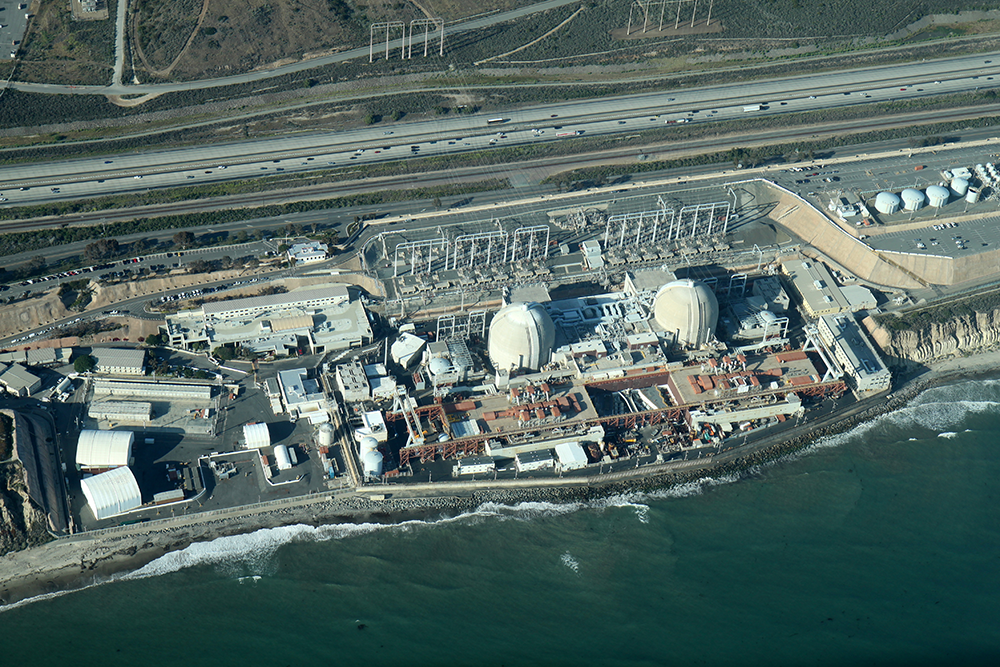
Low energy prices as a result of the fracking boom have also impacted the nuclear energy sector, leading to the shutdown of nuclear power plants across the country. (Photo: Jelson25; Wikimedia Commons CC BY-SA 3.0)
DYKSTRA: Another place where the low energy prices are hitting home is with the U.S. nuclear industry. In the past couple of years, aging nukes have been shut down in Florida, California, Wisconsin and Vermont as they get more expensive to maintain and less competitive with natural gas power plants. New nuclear plants on the drawing board for Maryland, Florida, Texas and elsewhere have been dropped, and the only current nuclear construction projects are struggling with delays and cost overruns.
CURWOOD: But wait a second, we still get, what, close to twenty percent of our power from nukes. Does that mean the industry is just too big to fail?
DYKSTRA: As in a bailout? Well, there are more nuclear plants on the brink of closure in Ohio, Illinois and New York, and in all three places, electric utilities are appealing to state governments to re-structure electric rates to give these nukes a shot at survival.
CURWOOD: And who’s gonna pay?
DYKSTRA: Ratepayers, of course! Wouldn’t it be cool if public radio and nonprofit news shows could just hang the cost on listeners like this? You might be richer than Harold Hamm, Mr. Curwood!
CURWOOD: Yeah, I’ll get back to you on that one! So do you have some history for us this week, Peter?
DYKSTRA: Indeed I do. My colleague Marianne Lavelle wrote a piece about the Fiftieth Anniversary – this weekend – of the first time an American President made public mention of CO2 and its impact on the climate. That President? The old tree-hugger himself, Lyndon Baines Johnson.
CURWOOD: You know, of all the things that happened in the Sixties during LBJ’s presidency, Peter, I gotta admit climate change would be one of the last that I’d think of.

Fifty years ago, President Lyndon B. Johnson became the first president to raise the issue of anthropogenic climate change with a Congressional address. (Photo: Arnold Newman; White House Press Office)
DYKSTRA: But on February 8, 1965, Johnson sent a Special Message to Congress – it was a written message, no speech – and President Johnson said this: “This generation has altered the composition of the atmosphere on a global scale through radioactive materials and a steady increase in carbon dioxide from the burning of fossil fuels.”
CURWOOD: Huh, so it’s been fifty years since the Most Powerful Man in the Free World has told us we’ve got a problem...
DYKSTRA: ...and now we have a bigger problem. Something else remarkable about that message from LBJ: He pretty much ran through the entire environmental agenda for the rest of the 20th Century to this day: toxic waste, air and water pollution, parkland, pesticides, and more.
CURWOOD: So what do you think gave LBJ such a good long-term view?
DYKSTRA: Well, he listened to scientists. What a concept!
CURWOOD: What a concept indeed! And you can find these stories, LBJ’s remarkable message and more at LOE.org. Thanks a lot, Peter.
DYKSTRA: Thanks, Steve, anytime.
CURWOOD: Peter Dykstra is with Environmental Health News, EHN.org and TheDailyClimate.org.
Related links:
- Alpha Natural Resources announces mine closures
- “Analysis: Last tango for nuclear?” reported by Environmental Health News
- A 50th anniversary few remember: LBJ’s warning on carbon dioxide
- LBJ’s “Special Message to the Congress on Conservation and Restoration of Natural Beauty”
[MUSIC: U2 Walk to the Water. The Joshua Tree Remastered, 2007]
Probing Dolphins’ Genetic Mysteries
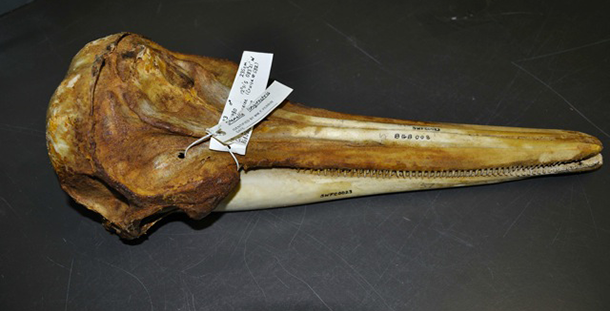
A skull of a spinner dolphin killed in the tuna fishery housed in the NOAA Southwest Fisheries Science Center's Marine Mammal Life History Collection. Detailed measurements of hundreds of skulls were used to determine how many populations of dolphins were affected by the fishery. (Photo: Matthew S. Leslie)
CURWOOD: Dolphins are among the most beloved of ocean creatures. They are renowned in myth, and reality, for rescuing drowning humans, and leading boats safely through treacherous waters. Humans have also killed massive numbers of dolphins in the warm Pacific, because pods often associate with schools of tuna targeted by fishing boats. Ironically the huge numbers of animals killed before the Dolphin Protection Act came into effect in the US twenty-five years ago have yielded a unique genetic archive, and that’s the subject of this report in the series “One Species at a Time”. Matthew Leslie, a PhD candidate at the Scripps Institution of Oceanography in La Jolla, California has the story.
LESLIE: Sometimes an environmental problem is so difficult that it requires multiple
generations to solve. That’s certainly the case when it comes to the story of the two species I study: spotted dolphins, or Stenella attenuatta, and spinner dolphins, or Stenella longirostris.
I'll get to my work on these species in a minute, but first I need to give you some background.
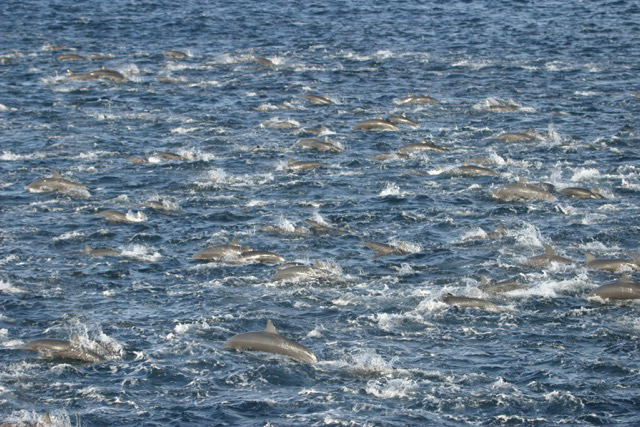
A school of eastern spinner dolphins fleeing from research vessel. Spinner dolphins in most other parts of the world do not exhibit this response to vessels. The “flee” behavior is likely a response to the chase and encirclement methods of “dolphin set" tuna fishing in this region. (Photo: Robert L. Pitman of the National Marine Fisheries Service)
LESLIE: In the eastern Pacific, thousands of miles from land, spotted and spinner dolphins have a special bond with large tuna – they're almost always found together. Fishermen have known this for a long time, and they’ve come to rely on the dolphins they see at the surface to find schools of tuna below. For years, they used fishing poles to catch tuna. But all that changed in the 1960s with the advent of large plastic nets.
PERRIN: I went on a boat back in 1966 and saw the operation.
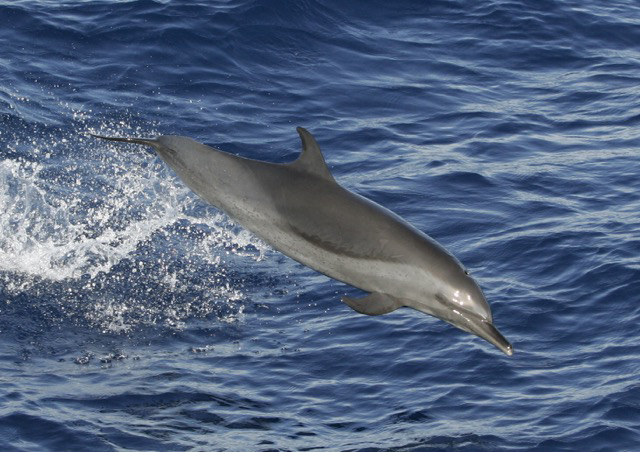
A pantropical spotted dolphin from the eastern tropical Pacific Ocean. (Photo: Robert L. Pitman of the National Marine Fisheries Service)
LESLIE: This is my research advisor, Bill Perrin. He retired a few weeks ago, after working 46 years as a biologist with the National Oceanic and Atmospheric Administration, or NOAA. Back in the 60s, Perrin was a PhD student researching the fishery.
PERRIN: I was very impressed by it...tremendous stresses involved, great winches working in all a big industrial operation.
LESLIE: Nets a mile long could encircle entire schools of fish. Boats were harvesting more tuna than ever, but countless dolphins were paying the price.
PERRIN: The dolphins were trapped and many of them didn't make it out.
LESLIE: Perrin saw over a thousand dolphins die on a single fishing trip. He was deeply troubled. So he started a program to train over a hundred and fifty biologists to be observers on tuna boats.
The idea was to count how many dolphins were being killed, and collect as many samples as possible to understand the impacts on the dolphins.
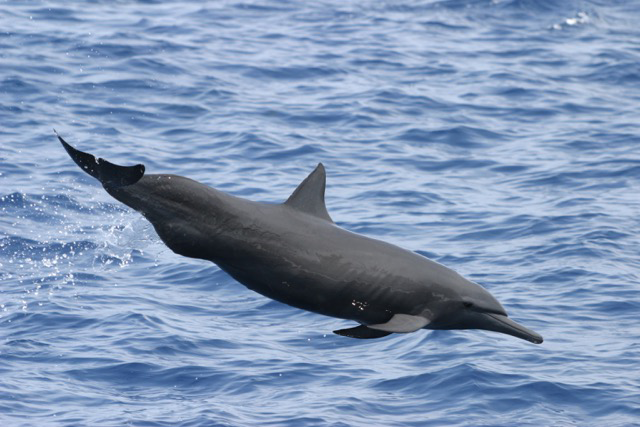
An eastern spinner dolphin from the eastern tropical Pacific Ocean. (Photo: Robert L. Pitman of the National Marine Fisheries Service)
LESLIE: In addition to the first estimates of how many dolphins were dying, the effort resulted in the best collection of dolphin tissue in the world, and it resides at NOAA's Southwest Fisheries Science Center, located right here on the Scripps campus. I call it the morgue. Susan Chivers is the curator, and she offered to show me around.
CHIVERS: It’s a very big space.
LESLIE: The room is about the size of a small gymnasium. It’s clean and bright with floor-to-ceiling shelves, each one packed with jars containing dolphin body parts.
CHIVERS: Here we have a wall of gonads; banks and banks of ovaries.
LESLIE: One shelf is packed with jars containing hundreds of jawbone fragments. Biologists used the teeth from these jaws to determine the age of the dolphins.
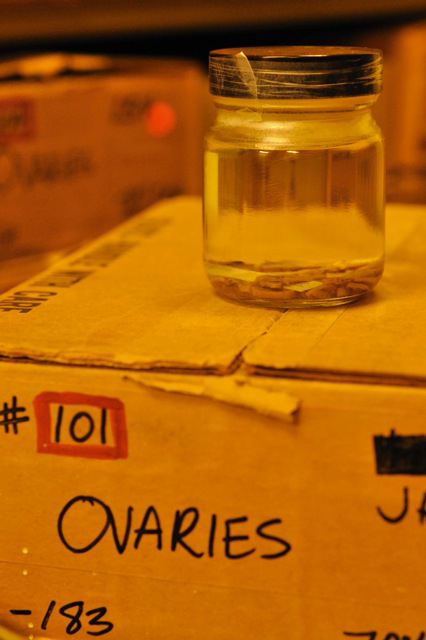
A jar containing the ovaries of a dolphin killed in the tuna fishery. We used the ovaries were used to determine whether the dolphin was sexually mature. This specimen comes from one of over 30,000 animals whose remains are housed in the NOAA Southwest Fisheries Science Center's Marine Mammal Life History Collection. (Photo: Matthew S. Leslie)
CHIVERS: It is moving for people to see - when you realize that the jaws of over 40,000 dolphins are here on these shelves. It does kind of bring it home to you how many dolphins were actually killed.
LESLIE: Over six million dolphins died as a result of this tuna fishery. And all those dead dolphins didn't go unnoticed.
PERRYMAN: The level of mortality became visible to the American public.
LESLIE: This is Wayne Perryman, a biologist at NOAA. Public outcry forced the fishermen to change their nets, and the way they haul them in, which allows the dolphins to escape. The kill is down from hundreds of thousands of animals a year to only about a thousand. You’d think that would be a good thing, but Perryman says the spotted and spinner dolphins still haven’t recovered.
PERRYMAN: We don't know why it’s taken so long. Maybe the fishery is having an effect we can’t measure. Maybe this is just the nature of populations.
LESLIE: Populations are just groups of individuals that don't really mix with one another, and to recover a species, we have to make sure that all the populations are recovering.

A jar containing jaw fragments from dolphins killed in the tuna fishery. We used these specimens to determine the age of each dolphin. They are housed in the NOAA Southwest Fisheries Science Center's Marine Mammal Life History Collection. (Photo: Matthew S. Leslie)
LESLIE: When Bill Perrin measured the dolphin skulls in the morgue, he found three populations of spinner dolphins and two populations of spotted dolphins. For the last 20 years conservationists have used these population definitions to manage the dolphins. But Perrin suspected early on that his approach was too coarse - that maybe there were even smaller groups, subpopulations, that need special protection.
That's where I come in. I'm using DNA that comes from the morgue to look for these
subpopulations. I assumed that because the skulls were different, the genes would be too. But when I looked at 14 different genes – I couldn't see the differences Perrin found. This doesn't mean they're not there, I think I'm just looking in the wrong place.
Now I'm scanning all the DNA of these dolphins - their entire genomes –hoping to find the subtle differences that reveal the smaller populations - so we can get the recovery plan right. My advisor Bill Perrin had no idea when he was collecting dead dolphins in the 60's, that one day we’d be able to peer inside their cells and read their DNA. And yet, the mission’s the same – saving the dolphins - and it makes this 40-year-old morgue as important as ever.
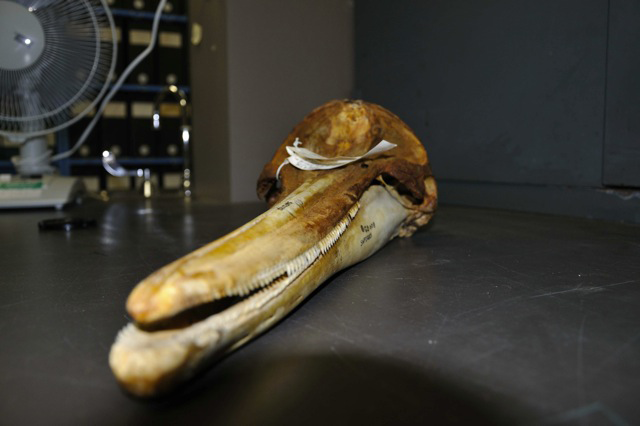
A skull from a spinner dolphin killed in the tuna fishery housed in the NOAA Southwest Fisheries Science Center's Marine Mammal Life History Collection. Detailed measurements of hundreds of skulls were used to determine how many populations of dolphins were affected by the fishery. (Photo: Matthew S. Leslie)
PERRIN: The tuna fisheries continue. We're not 100 percent sure that what they're doing is fully sustainability. We have data and specimens here that may help us answer that question. It’s a gold mine.
LESLIE: I’m honored to be following in Perrin's footsteps, to solve a problem that my generation inherited from his and applying the latest tools in science to specimens collected well before I was born.
CURWOOD: That’s Matthew Leslie, a PhD candidate at Scripps Institution of Oceanography. His story is part of the series, One Species at a Time, produced by Ari Daniel and Atlantic Public Media in Woods Hole, Massachusetts, with support from the National Science Foundation.
Related links:
- More on the dolphin problem in tuna fisheries
- Matthew S. Leslie is a PhD candidate at the Scripps Institution of Oceanography
- Matthew S. Leslie’s personal page
- Study from Scripps on how fisheries impact dolphin populations
Eyes on the Seas
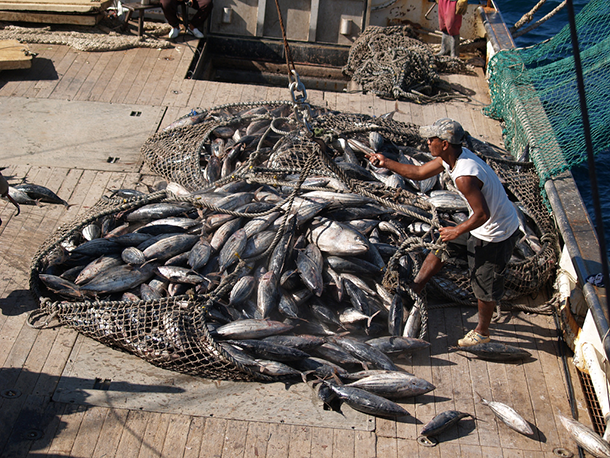
As of January 1st, 2015, commercial fishing has been banned in the seas around Kiribati. (Photo: AusAID; CC BY 2.0)
CURWOOD: Now, verifying that the tuna in tins on our shelves is “dolphin-safe” requires careful monitoring of how fishing boats are operating. In the quarter century since that program was introduced, observation has become increasingly sophisticated. And as more and more marine protected reserves are created – places where no fishing is allowed for conservation reasons – technology is playing a critical role. Joining us to discuss the monitoring of marine protects areas is Joshua Reichert, Executive Vice President of the Pew Charitable Trusts, which has ambitious plans to facilitate the creation of marine protected areas and has developed advanced monitoring systems. Welcome to Living on Earth.
REICHERT: Thank you.
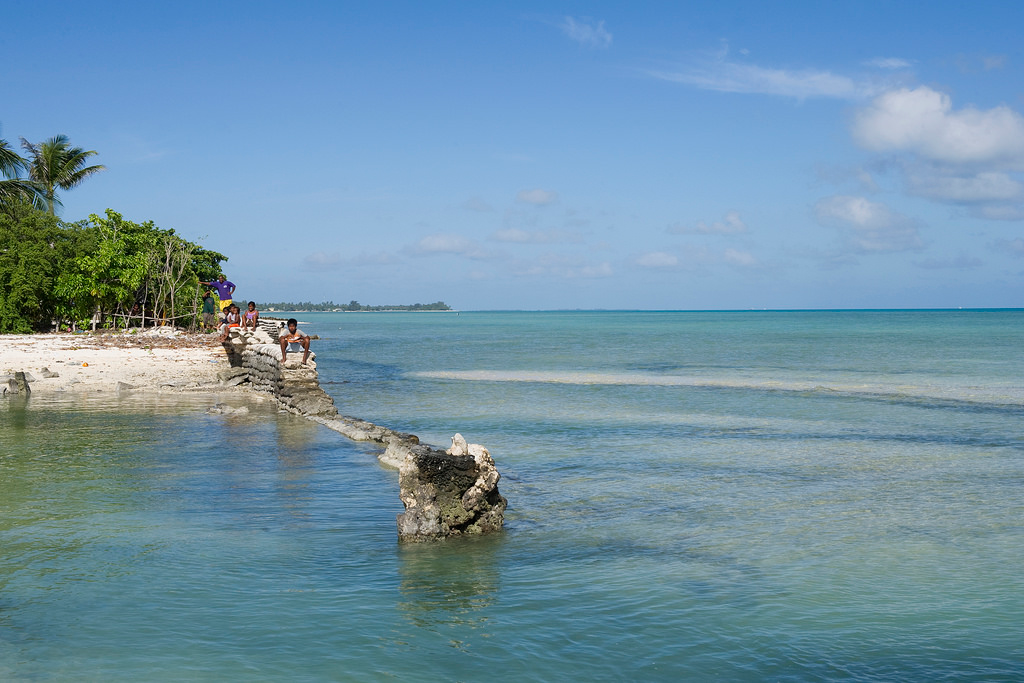
The Phoenix Islands Pacific Area is a marine reserve around the country Kiribati. (Photo: United Nations Photo; CC BY 2.0)
CURWOOD: I want to talk about your technology, but first, tell me why does it make sense from a conservation perspective to prevent fishing in large areas of the ocean?
REICHERT: Well, ocean systems are in many respects like land-based systems in that they harbor a lot of different life forms, and as time has gone on, extractive activities in the ocean – fishing, mining, oil and gas production and exploration - all affect these systems in one way or another. And we're steadily losing examples of big ecosystems in the world's oceans that function the way they did before human intervention. So if we're going to protect these places in the way in which some of them need to be protected, marine reserves are the best way to do that.
CURWOOD: Now the people who fish say, "Look, fish travel all over the ocean", the pelagic ones anyway. So, if people aren't catching fish in a marine protected area, why wouldn't they just catch them someplace else?
REICHERT: Well, sometimes they do catch them somewhere else, and obviously in the case of pelagic animals that move 3,000 miles a year, they go in and out of the exclusive economic zones of individual countries, and they head for the high seas. But the ability at least in select areas and areas where they spend a fairly large amount of time, to offer them some safe harbor where they're not constantly pursued, means that in general the mortality rates tend to go down.
CURWOOD: Kiribati has a large marine protected area that it's announced that it would prohibit any fishing in beginning the first of this year. How do you monitor something like that?
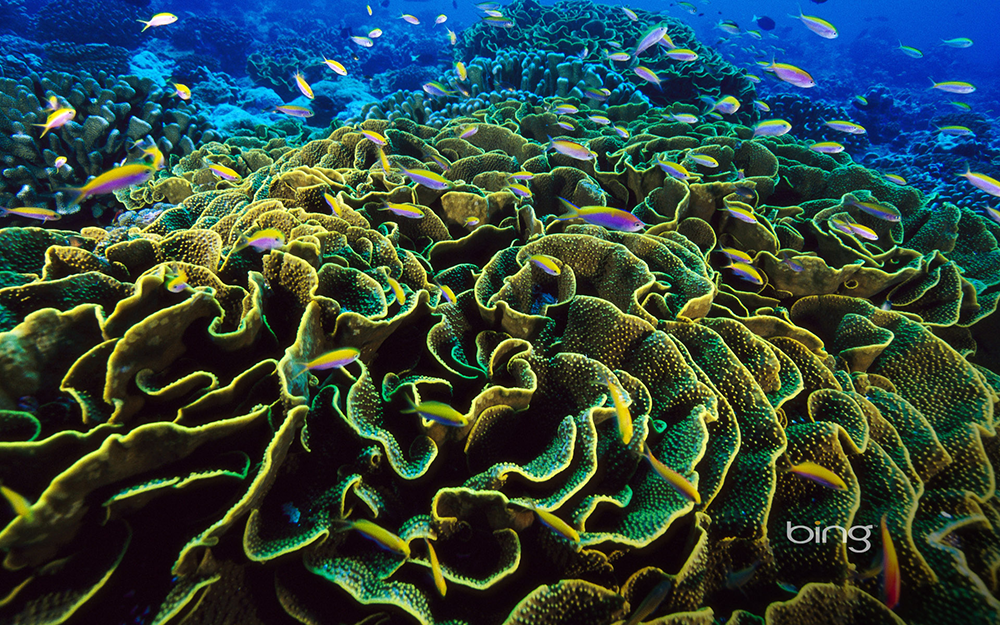
Phoenix Islands, Kiribati (Photo: Szecska; Flickr CC BY 2.0)
REICHERT: Up until recently the conventional way to deal with the enforcement was to usually interdict vessels on the open ocean. It's too expensive to do that now, and the days of chasing illegal fishing vessels on the open ocean are really coming to an end. There was an incident back in 2003 in which a fishing vessel that was flagged to Uruguay and was suspected of carrying illegally caught Patagonian Toothfish was pursued by patrol boats belonging to Australia, the United Kingdom, and South Africa. After a chase that went on for 7,200 kilometers, and that lasted 21 days, the vessel which was named the Viarca 1 was apprehended, and the value of the cargo which was 97 tons of illegally caught Toothfish that was found on board, was estimated roughly $1.5 million US dollars. The cost of apprehending that vessel was calculated at more than $4.5 million. So, we're entering a period of time in which just the cost of diesel fuel and the cost of maintaining patrol vessels is getting to be prohibitive for many countries.
CURWOOD: When it comes to enforcement you say it's too expensive to go out and interdict these vessels. How then can you enforce these areas?

The Eyes on the Seas program will help monitor commercial fishing activity and track boats that maybe fishing illegally. (Photo: Nick Rahaim; Flickr CC BY 2.0)
REICHERT: Well, it's a little bit like a spider and the fly. There's a variety of technologies related to these satellites, radar systems, optical imagery -- there’s a whole list of various technologies that can be used to determine whether or not there are boats in areas like this where they shouldn't be, and whether they're fishing. We have algorithms that can be used to determine whether a boat is traversing an area in more or less a straight line from point A to point B as opposed to movement patterns which would suggest that it's fishing.
CURWOOD: Now as I understand it, your organization recently launched a technology that will help authorities monitor, detect and even respond to elicit fishing activity in various reserves around the world. You call this Project Eyes on the Seas. How does this work and how is it going to reduce illegal or pirate fishing?
REICHERT: This system that we've developed depends on a variety of different data sources to create a portrait of what a vessel is doing in a particular area. So the system is designed to be able to pick up whether a vessel is within a restricted area and then to identify it, and then after that essentially to track it as it moves along either in the restricted area or, as it leaves, to track it where it's going, and we have a whole group of people who were developing very comprehensive dossiers on fishing vessels to try and allow port authorities to make some kind of reasonable decision about whether or not these vessels should be searched when they come into port.
CURWOOD: Before you go, Josh, what are your long-term goals or targets when it comes to marine protected areas?
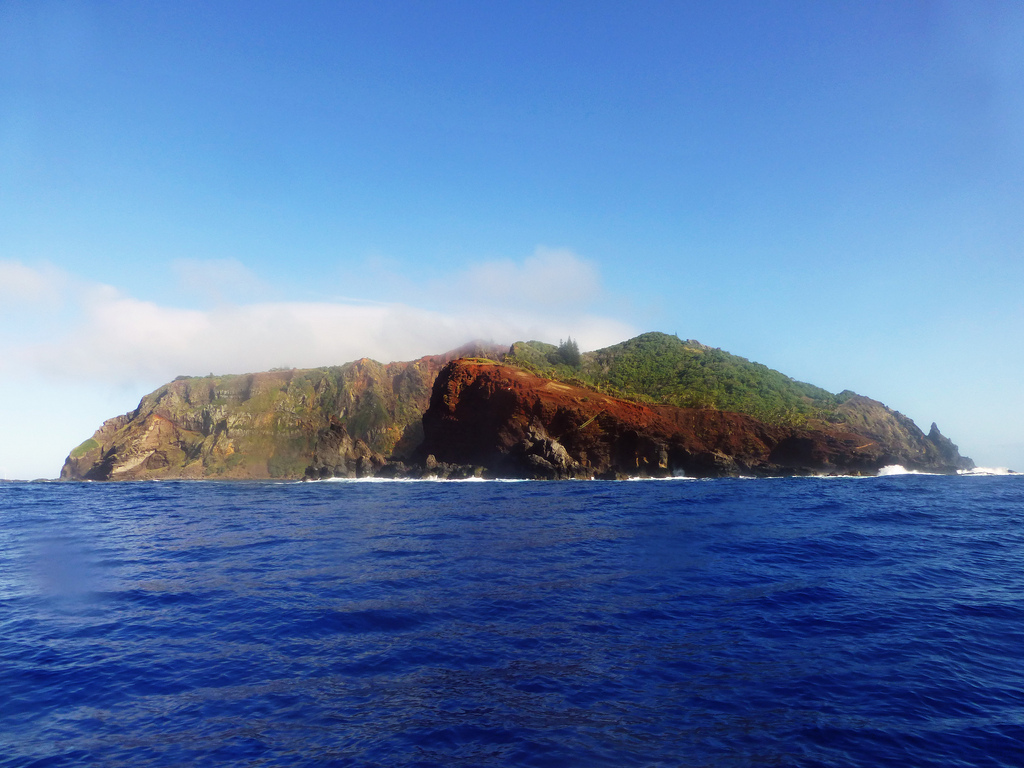
Pew is hoping to establish a marine protected area around Pitcairn Island in the South Pacific. (Photo: doublecnz; Flickr CC BY 2.0)
REICHERT: We have a variety of goals, one of which is to try to ensure that there's a certain percentage of the world's oceans that's pretty much left intact, where the ecosystems and the life that inhabits them, that interacts with each other, can teach us what a natural system looks like when it's healthy. There're a few places that are of any size that haven't been impacted in one way or another by human activity.
CURWOOD: How large of a percentage are you talking about, do you think?
REICHERT: Well, I think that when we started this work about 10 years ago, the estimates were that there was less than one half of one percent of the world's oceans that was protected in a comprehensive way. So it's been a great challenge to try and increase the percentage of areas that really are protected.
CURWOOD: What is the goal of your campaign to increase the number and sizes of marine protected areas...are you looking for 10 percent around the world?

Joshua Reichert is the Executive Vice President of the Pew Charitable Trusts (Photo: Pew Charitable Trusts)
REICHERT: Fisheries biologists, marine ecologists will tell you 20 percent or more. You know, aside from climate change, which is eventually going to affect all life in the sea, the greatest threat to the world's oceans is fishing. The numbers in terms of tonnage are staggering. We're massively overfishing most of the world's oceans in ways that affect their health as a whole. We've been fishing as if there were no tomorrow, and we really need to stop that.
CURWOOD: Joshua Reichert is Executive Vice President of the Pew Charitable Trusts. Thanks so much for taking the time with me today, Josh.
REICHERT: Thank you, Steve. It was a pleasure.
Related links:
- Watch a video on the Eyes of the Seas program from Pew
- Josh Reichert’s page at Pew
- Read more about efforts to protect the area around Kiribati
[MUSIC: Frank French--“Womba Bomba”, terra verde 1997]
CURWOOD: Coming up...diving on one of the world’s most amazing reefs – in Cuba. That's just ahead on Living on Earth. Stay tuned.
ANNOUNCER: Funding for Living on Earth comes from United Technologies, a provider to the aerospace and building systems industries worldwide. UTC Building & Industrial Systems, provides building technologies and supplies, container refrigeration systems that transport and preserve food, and medicine with brands such as Otis, Carrier, Chubb, Edwards and Kidde. This is PRI, Public Radio International.
[CUTAWAY MUSIC: Steve Reich Ensemble, Music for 18 Musicinsia 11 Section 1, Nonesuch 2005]
Cuba's Unspoiled Tropical Reefs
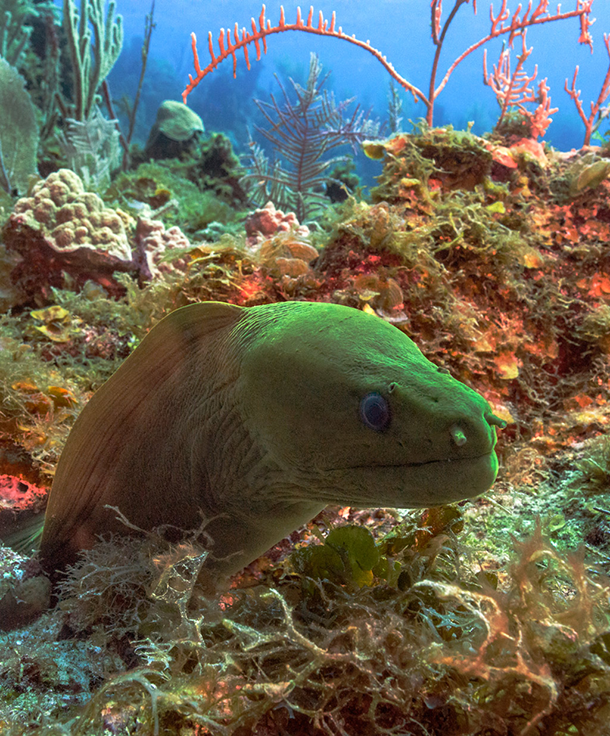
Reef Libre: The Last, Best Reefs in the World is diver and photographer Robert Wintner’s most recently published book. (Photo: courtesy of Robert Wintner)
CURWOOD: It's Living on Earth. I'm Steve Curwood. One of the biggest surprises at the end of 2014 was the unexpected thaw in US-Cuba relations. Cuba, a mere 90 miles to the south at its nearest point, has been a thorn in American flesh for over 50 years. But tough economic sanctions, relentless propaganda and deep hostility from many Cuban exiles in Florida have not changed the island’s brand of communism. For many Americans without direct family ties, one hope of renewed ties with Cuba is the chance to visit another jewel of the Caribbean, blessed with glorious beaches and weather. And for divers, there is now a better chance to see its breathtaking and unspoiled coral reefs -- and most fortuitously, a new book called “Reef Libre” that looks at just those famed reefs arrived in our office. It’s written by Robert Wintner, a.k.a. Snorkel Bob, who’s on the line now from the island of Maui, in Hawaii. Aloha, Mr. Wintner.
WINTNER: Aloha to you.
CURWOOD: Now, your book is very timely. Come on, tell me...you got some kind of tip off on this political thaw?
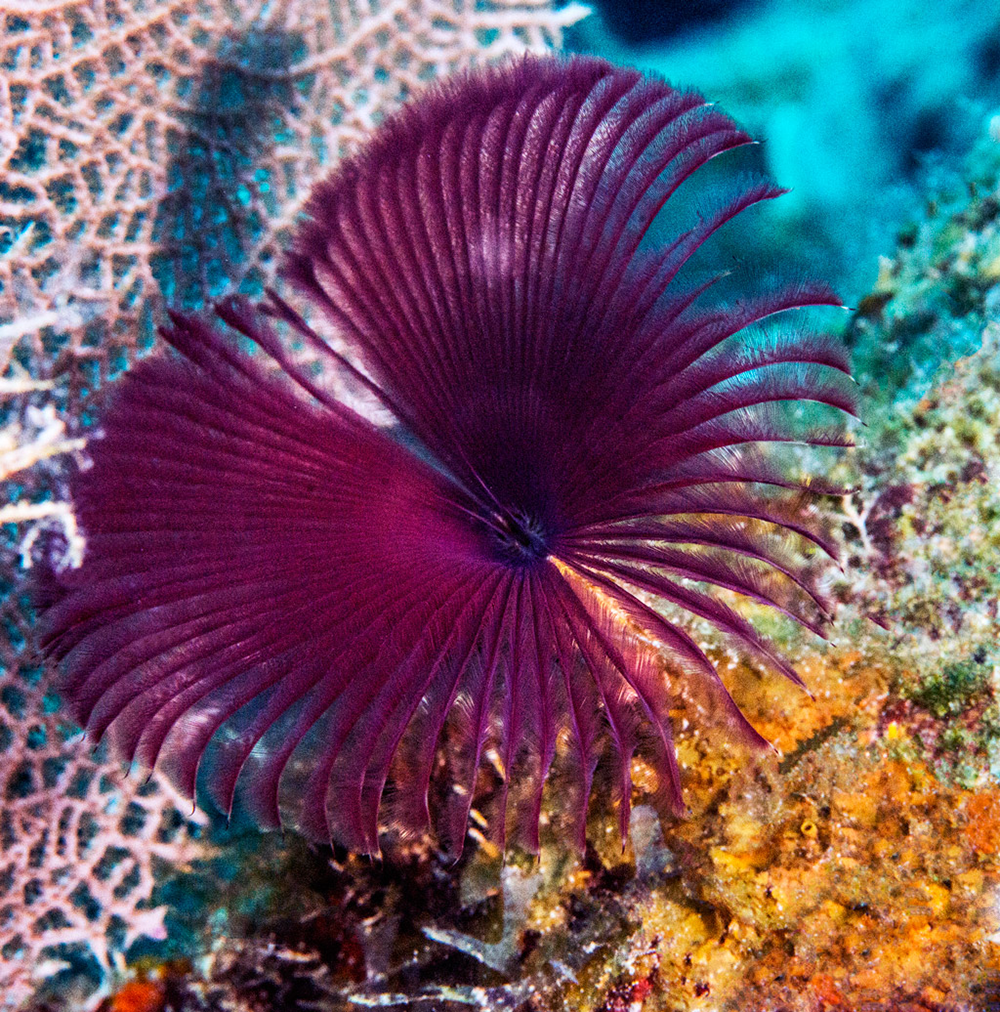
The reefs at Jardines de la Reina are nothing if not showy: a filter-feeding purple sea fan maximizes its surface area with an intricate network of connected branches. (Photo: Robert Wintner)
WINTNER: Well, you know I think it was not anything that was very complex or unpredictable. I will admit our timing was superb. I thank Neptune for that. We got word of this particular reef system was being called the last best reef system in the world, and the three qualifiers for that rating were 100 percent biodiversity, that means all the species that were ever there are there now, and in fact some they thought were extinct, 100 percent coral cover and 100 percent host of apex predators, and that was the key right there to restoring these reefs to healthy conditions. No natural system can survive intact without apex predators, that's what allows every level of the food chain beneath it to be at optimum balance, and the glaring example in the world today is Cuban reefs, our Jardines de la Reina. That's the ocean people talk about, that the world used to have, that we used to love. It's there in in Cuba.
CURWOOD: So you heard about these reefs there in Cuba. You decided you got to go and get on a plane and get off at Havana. Talk to me a bit about some of the places that you dive in Cuba.
WINTNER: Well, we dove in Havana for a baseline. I wanted to get a measure of reef conditions in an urban setting. Urbanity is the biggest challenge to wildlife and wildlife habitat. We went from there to Cayo Largo. The problem with Cayo Largo is they have a 600-room hotel and they were cleaning the sheets and towels with phosphate based detergents - direct drive graywater right on to the reefs. So there is no snorkeling at Cayo Largo. The near shore shallow reefs at Cayo Largo are dead. They don't exist. When we went to deeper water and dived, and if we got either side of the outflow currents then the reefs were beautiful, as beautiful as anywhere in Cuba, and then we come to Jardines and it was just beautiful.

Thanks to the fishing ban, which has been in effect in for the past several decades, grouper and other apex predators are plentiful on Cuban reefs. Wintner says that grouper used to be abundant in Hawaii as well, but fishing and tourism impacts have reduced the Hawaiian grouper population. (Photo: Robert Wintner)
CURWOOD: Robert, I don't want to sound dismissive when I say this, but at least half of your book consists of pictures of some of the most glorious assortment of brilliantly colored exotic and wondrous fish all taken in Cuba. How many of them are truly unique?
WINTNER: Let me give you a glaring example. Most people who live in Hawaii and especially people who visit, all don't realize that Goliath Groupers once swam in abundance in Hawaii, and today you will find zero. Most reefs in the world, most reef areas, reef systems have zero Goliath Groupers and that's because they get up to 400 or 500 or 600 pounds, and that's a lot of meat on the table, and they are all gone. To put it in a nutshell, one day Fidel Castro said, "No mas." The big rule that he imposed was no more killing the sharks.
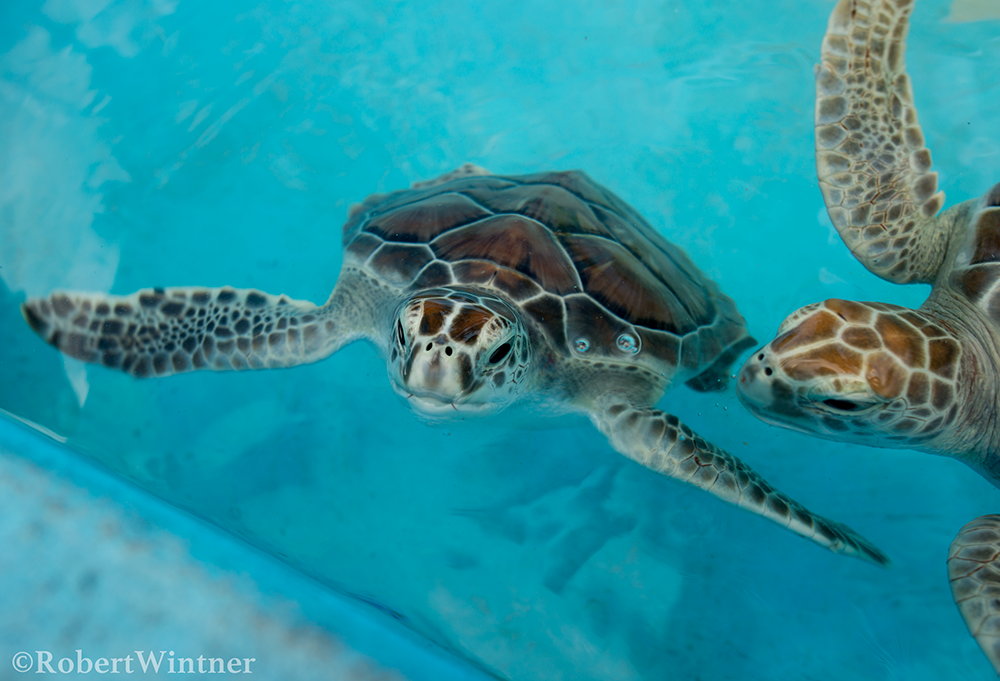
Run-off pollution from a large hotel on Cayo Largo’s beach has severely damaged its near-shore shallow reefs. In the deeper water outside of the outflow currents and pollution, the reefs remain rich in sea life, including this pair of sea turtles. (Photo: Robert Wintner)
WINTNER: Everybody should be aware now of the shark fin soup issue, and the fella I interviewed in Cuba relayed this information and I said, "But why were your sharks threatened? You're nowhere near Asia," and he said, "We ate our sharks. They were our staple protein." And whatever you want to say about capitalism or communism becomes incidental to the fact that Fidel Castro one day said, "No mas," on shark killing; the sharks came back. Now, with the sharks are the big Groupers, the biggest Grouper species are Goliaths, and they're all over Jardines de la Reina.
CURWOOD: Now, Robert you make a point of contrast in Hawaii where you live and where you have your business, Snorkel Bob, with Cuba. Talk to me about what Cuba has going for it here.
WINTNER: In Hawaii, we have a Department of Land and Natural Resources that is mandated for most efficient extraction of ocean resources, whereas they should be mandated for conservation and they're not, and the example that's most touching to me is the wild west situation with the aquarium trade in Hawaii and the massive extraction and trafficking in reef wildlife for the pet trade. Cuba's reef management is focused on conservation and redemption.
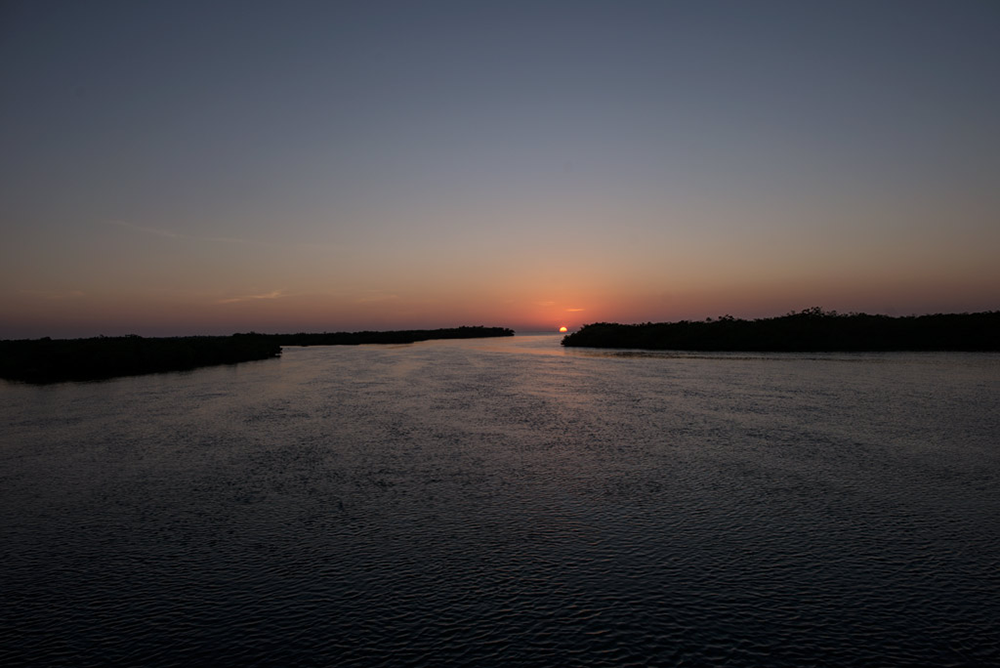
Jardines de la Reina, “The Gardens of the Queen,” is part- mangrove forest, part- coral reef. (Photo: Robert Wintner)
WINTNER: Our big measure in Havana was the presence of what we call feather dusters. They are a polychaete worm. They bore into the coral and then they filter feed with these amazingly beautiful feather duster filter tails. In Hawaii, at a place called Kaneohe Bay on Oahu, the feather dusters all went to aquarium extraction. There none left. On Havana reefs, we saw feather dusters in the hundreds, in fact, probably in the thousands; we saw them in clusters. They were everywhere and it's an indicator that these reefs are...that they have healthy water quality and they're also un-oppressed with any form of extraction.
CURWOOD: How important in your view is the home aquarium business and its impact on coral reefs?
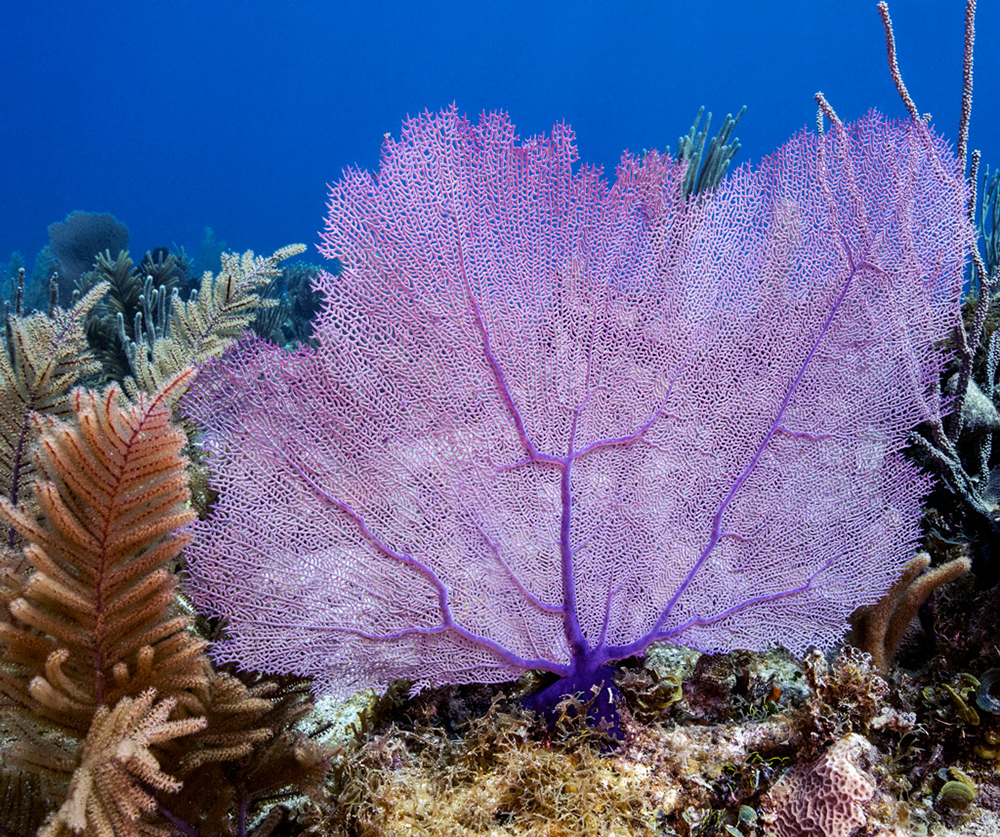
The reefs at Jardines de la Reina are nothing if not showy: a filter-feeding purple sea fan maximizes its surface area with an intricate network of connected branches. (Photo: Robert Wintner)
WINTNER: It's huge. It's devastating reefs around the world. It's one of the last vestiges of trafficking in wildlife for the pet trade. Most people assume that somebody somewhere is growing those fish. They're not. This is wildlife taken from reefs. One of the biggest debacles in ocean conservation in our time is the Lionfish invasion of the Atlantic and Caribbean Sea, and that was brought to by the aquarium trade. The Lionfish did not swim there. There are now more Lionfish in the Atlantic and Caribbean than all other species combined.
CURWOOD: What exactly happened with the Lionfish and the aquarium trade?
WINTNER: Lionfish are voracious predators. They occur naturally in the Pacific and Indian oceans and in those places where they occur naturally, predators eat them. In the Atlantic and the Pacific, the big predators are mostly the Groupers and the sharks, Moray eels and Barracuda, and when they would try to eat the Lionfish, Lionfish have big spines in their dorsal fins and are full of them, and if one of them stings you, you will not forget it. It will ruin your day. And so when the predators would go to eat Lionfish they'd get stung and they wouldn't eat them anymore.

In 1996, Fidel Castro declared Jardines de la Reina a Marine Park, banning all commercial fishing and ensuring that the reef would remain inaccessible to all but a thousand tourists each year. (Photo: Marcelo Montecino; Wikimedia CC BY-SA 2.0)
WINTNER: In Cuba, they catch the Lionfish and they despine them, which is tricky business. After they despine them, then they would feed them to the sharks and Groupers and Morays and I am told that the sharks were the best students. Once they got a taste for the Lionfish, they began eating them on their own - the live ones. In Jardines de la Reina, the divers used to go out and spear 40 to 50 Lionfish per dive. Now they go out and see two or three because the sharks there have learned to add Lionfish to their diet. So the problem's not going to go away, but they think it has stabilized now and it's under control.
CURWOOD: Robert, to what extent do you think that the lack of commercialism in Cuba has helped protect underwater life?
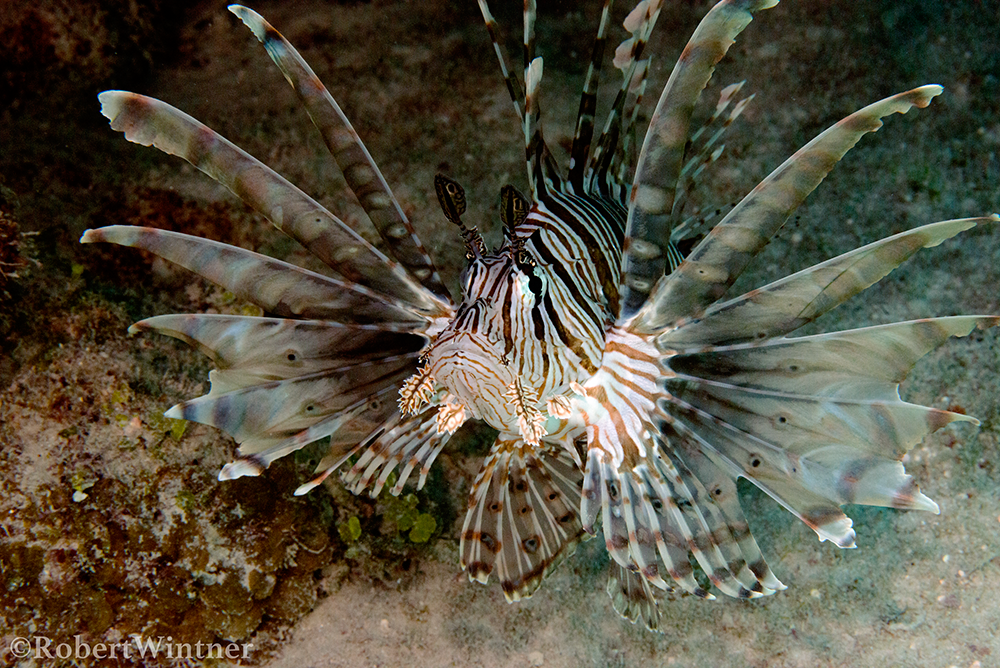
The lionfish may be spectacularly decked out with spines and stripes, but it’s a scourge of coral reefs to which it has spread, thanks to the aquarium trade. While natural predators in the Pacific and Indian oceans keep populations in check, invasive lionfish threaten native reef fishes in the Atlantic and Caribbean. (Photo: Robert Wintner)
WINTNER: The fella whom I interviewed the most, Fausto Dinetti was a diver at Jardines for six years and then they sent him up to Cayo Largo to try to redeem those reefs, and I said to him --we talked quite a bit about commercialism and what's going to save Jardines when the change comes -- my question to my friend Fausto is, "You have now, right now, a thousand people per year, which is very low traffic visiting Jardines, it's expensive and it's hard to get there." I said what's got to keep that from going to 3,000 when tourism opens up?" He says, "We won't let it get any bigger." I said, "Let me give you an example. If this was Hawaii, here's what would happen. A developer would come in and say, 'I have a proposition for you. I'm going to develop hotels, condominiums, timeshare resorts, and it's going to be jobs for people and everybody's going to be prosperous and here's the bottom line: the reefs not only won't be harmed by this, they'll be even in better shape when we are done,'" and Fausto's nobody's fool and he gave me a scowl and he said, "That will not happen here." And I said, "How can you be so sure. I've seen beautiful areas in Hawaii and elsewhere go the way of development, and once it begins you don't get it back."

A mature Atlantic blue tang begins life as an almost completely yellow juvenile, but by the end of its first year of life, the fish is sexually mature and nearly entirely blue. (Photo: Robert Wintner)
CURWOOD: What needs to be done by the international community in your view to protect these reefs off of Cuba?
WINTNER: I think that Jardines de la Reina could qualify as a world heritage site and end the potential of development at Jardines, and keep it a gem and a jewel and hard to get to, and hard to get a place to be there. And if you want to go you'll still go. A world heritage site I think would be the number one thing to happen to Jardines de la Reina and it should happen.
CURWOOD: How much do the Cuban people care about this resource?
WINTNER: That is the tough question because the Cuban people are so hungry. It's the same as asking how much do poor people all over the world care about their natural treasure if they're not seeing any part of it convert to dollars or money for them. In Cuba, there are two realities, two cultures, and two economies. A surgeon, a heart surgeon in Cuba makes $40 a month. So you tip a cabdriver $5 bucks, well, that's huge. That's a week’s pay for a surgeon.
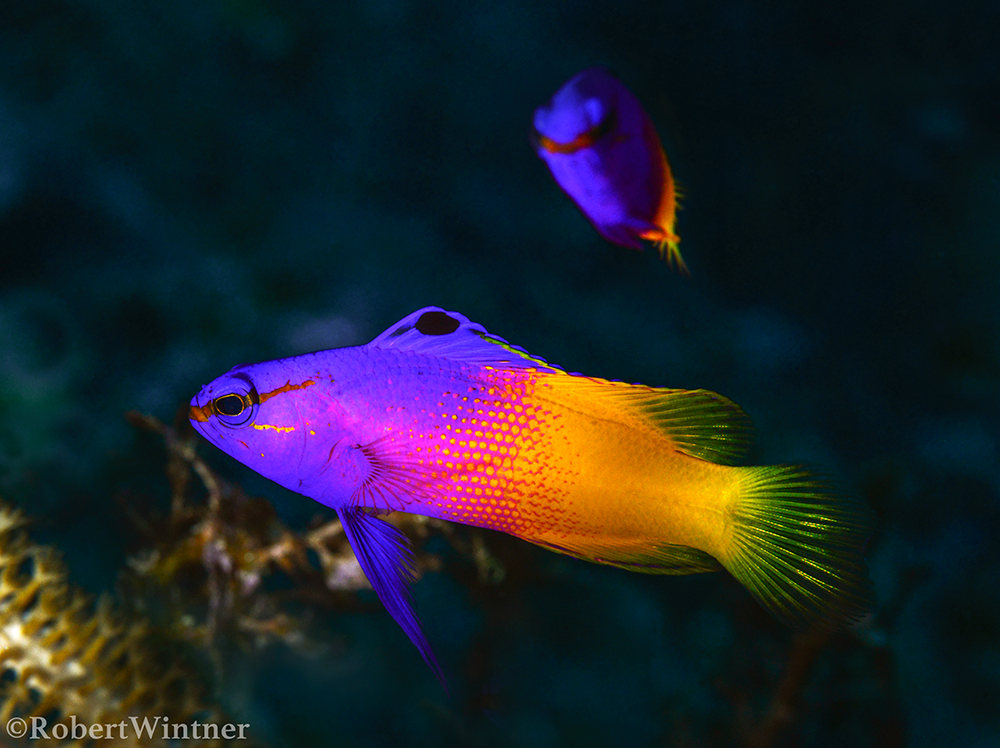
Fairy basslets can grow to three inches long and are known to swim upside-down along cave ceilings and ledges. (Photo: Robert Wintner)
WINTNER: People who have jobs in tourism are exposed to people like us who can tip $5 or $20 or $50 and the other culture in Cuba has no access or exposure to tourists, and they have nothing. Nothing, and it's difficult to imagine a life with nothing and maintaining conservation values. It's easy to love these treasures once you have a little food in your belly and it's a big challenge getting to that point.
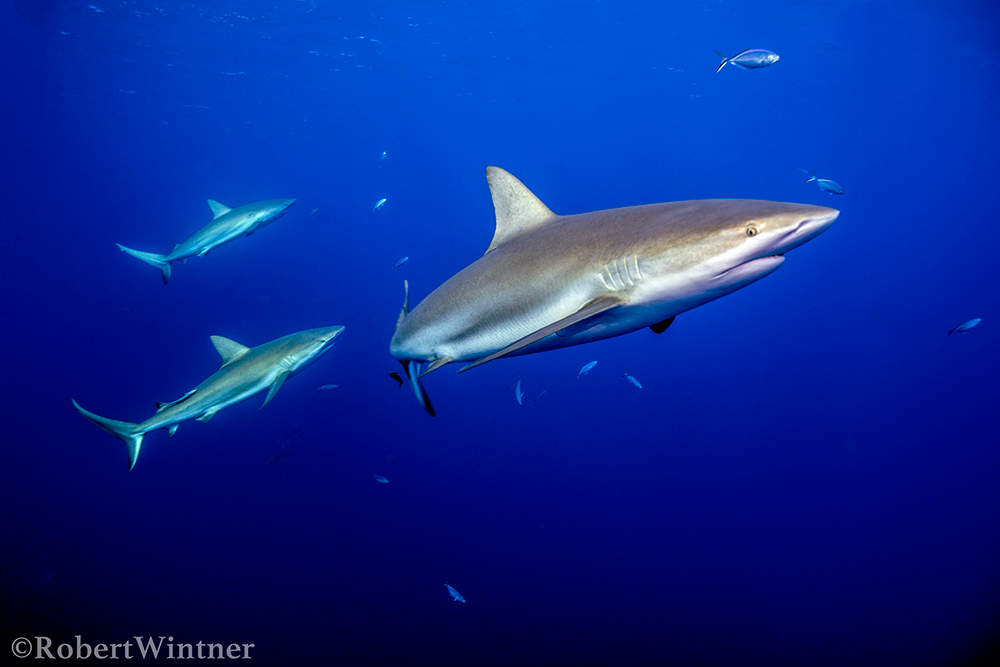
Sharks are plentiful in Cuban waters these days, but their numbers were greatly reduced prior to Fidel Castro’s fishing ban since Cubans relied upon shark meat as a primary source of protein. (Photo: Robert Wintner)
WINTNER: In Cuba when the sharks and the reefs started to come back they wanted to tag the sharks and they discovered this thing called shark spinning. All fish have what's known as a lateral line, and in that lateral line are all its senses and senses beyond the five senses we're familiar with. A fish knows, a fish senses using its lateral line. And on a shark, the lateral line converges right under the shark’s nose, and our friend Michael Echemendia was our main guide on board Jalcon at Jardines said that if you hold the shark’s nose right in the palm of your hand and then you play the piano -- and he tapped his fingers lightly -- it would put them to sleep and that would make the shark docile so they could tag them.
WINTNER: Meanwhile they also discovered that they could do whatever they wanted with that shark and so they would stand the shark on and tail up head down and spin it with the nose in the palm of his hand. And this was great entertainment for the tourists, and so when we showed up, one of the people on board said, "Shark spinning. We want to see shark spinning. And Michael said, "We don't shark spin anymore," and the guy who asked for it said, "Why not? I really...that's one of the things I was looking forward to." And he says, "Well, we have to compete in a world market." Boom! There's insight.
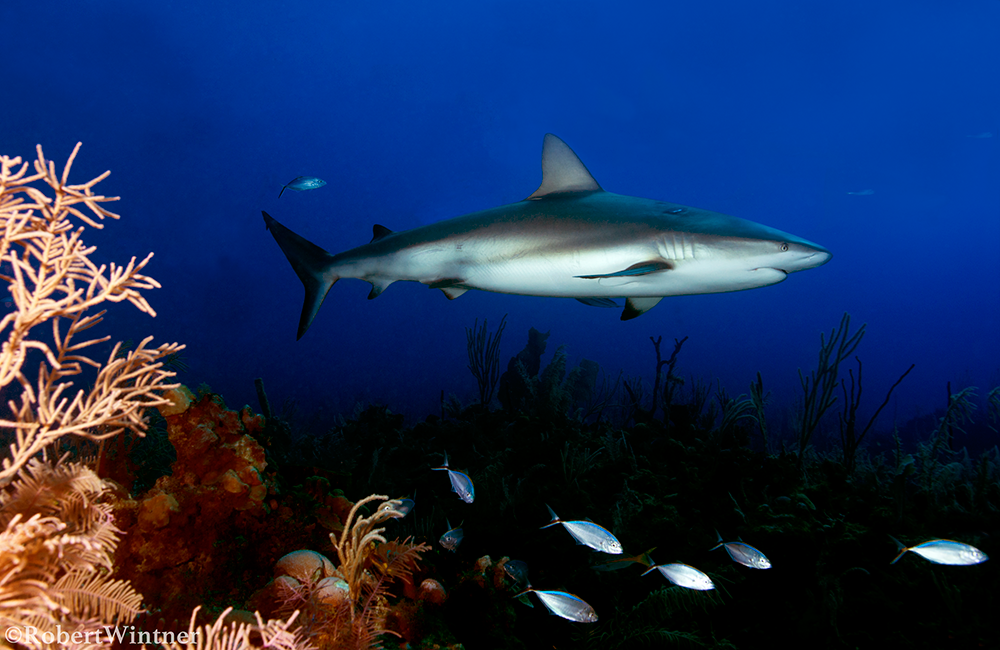
Wintner describes his close encounters with sharks in Cuba as “thrilling” rather than “terrifying.” He befriended a shark he named “Scarback.” (Photo: Robert Wintner)
WINTNER: There's communists aware of market competition and adapting to it. He said, "We have to compete in a world market and many people frown on shark spinning," and I, at that point said, "I want to thank you for not shark spinning because I'm one of those people who has a hard time with it. If you want to use it to tag sharks for productive benefit then that's fine, but to use it as a show for tourists, it's not fine." It was the right thing for him to say as far as I was concerned.
CURWOOD: Robert, what you hope your book does?
WINTNER: People have a general idea, they have a concept of reefs: reefs exist, yeah that's where fish live, and there's this colorful crusty stuff called coral. But until they see in detail, they just don't know. People think of fish and have for decades as something to roll up in a newspaper, something to have with tartar sauce.
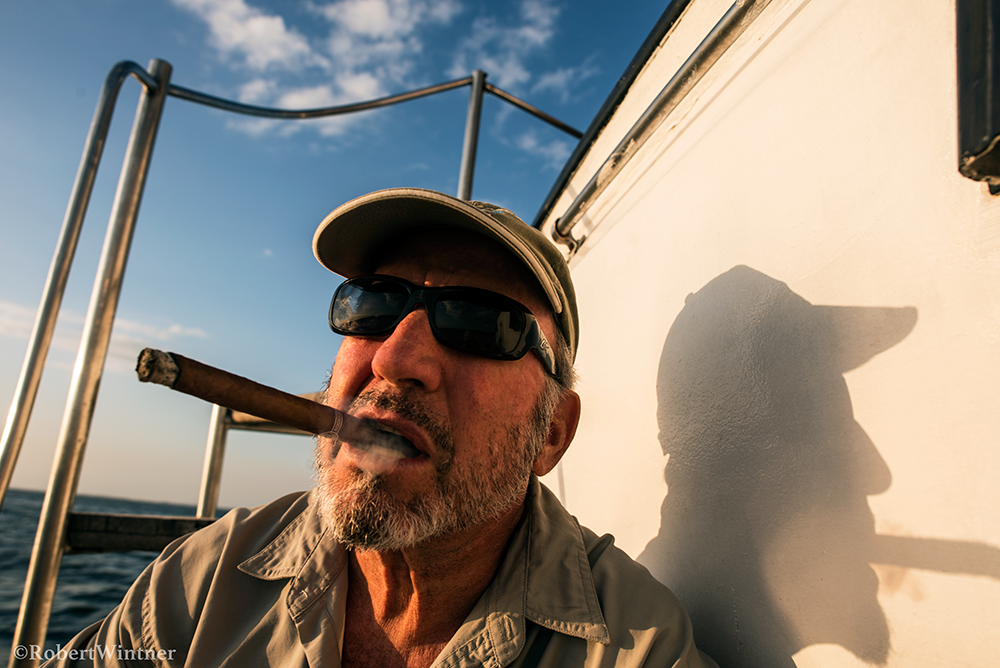
Robert Wintner, founder of Snorkel Bob’s shops throughout Hawaii, is a diver, photographer and author. (Photo: Keith Christie)
WINTNER: People have a hard time imagining cold-blooded gill-breathers as sentient beings. I got asked by a Taoism club in California once, "Can fish have a soul?" I said, "That's a perfectly humanistic question and I'd like to rephrase it: Can fish be a friend of mine? Oh, yeah." If you're out on a reef, and you're there more than once, the fish get to know you. We were able to identify certain sharks. There's one I nicknamed Scarback because she had a scar forward of her dorsal fin on the right side. She was very curious and did the normal feeding behavior, turning a circle around me and the radius got shorter and shorter. You know, by the fourth or fifth day we were so casual with shark company - I was out on my own one day and here came a shark, a huge shark right up to me and I looked - it was Scarback and I said, "Oh, it's you." And I thought, this is possibly complacence to a hazardous degree but it wasn't, and the shark familiarity was a great thing. In answer to the question, what can the book do? I think open people's eyes...not everybody can get onto a reef, and so the book is for those people and even those who do, often miss the detail, the engagement, the soulful contact that can occur there.
CURWOOD: Robert Wintner, or Snorkel Bob, is a diver, photographer, tour leader, sea life lover and author of the gorgeous book “Reef Libre”. Thanks so much for taking the time, Robert.
WINTNER: Thank you, Sir. I appreciate it.
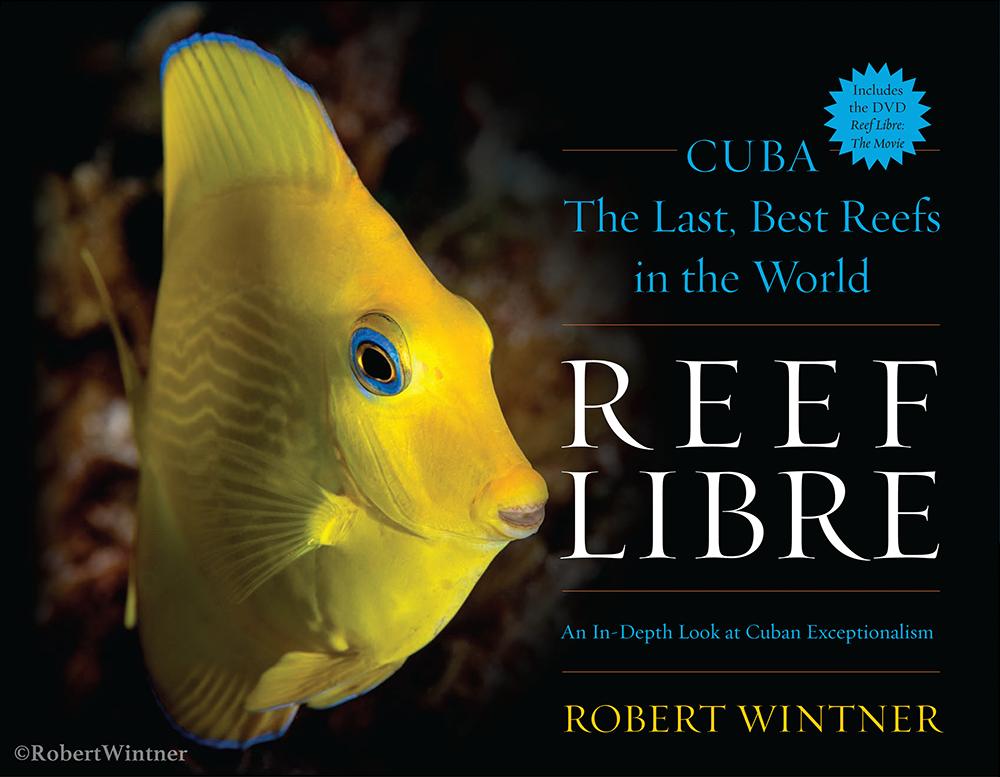
Reef Libre: The Last, Best Reefs in the World is diver and photographer Robert Wintner’s most recently published book. (Photo: courtesy of Robert Wintner)
Related links:
- Reef Libre and movie trailer
- “For the Sea” PSA on reef etiquette
- CBS 60 Minutes feature on Jardines de la Reina
- NOAA fisheries on invasive lionfish
- About Robert Wintner (Snorkel Bob)
[MUSIC: Sweet August Ham, Jawbone from Grand Picnic, 2005]
CURWOOD: Living on Earth is produced by the World Media Foundation. Our crew includes Naomi Arenberg, Bobby Bascomb, Emmett Fitzgerald, Helen Palmer, Adelaide Chen, Jenni Doering, Lauren Hinkel, James Curwood, Jennifer Marquis and John Duff. Our show was engineered by Tom Tiger, with help from Jake Rego and Noel Flatt. Alison Lirish Dean composed our themes. You can find us anytime at LOE.org - and like us, please, on our Facebook page – it’s PRI’s Living on Earth. And we tweet from @LivingOnEarth. I'm Steve Curwood. Thanks for listening.
ANNOUNCER1: Funding for Living On Earth comes from the Grantham Foundation for the protection of the environment, supporting strategic communication and collaboration in solving the world’s most pressing environmental problems. The Kendeda Fund, furthering the values that contribute to a healthy planet, and Gilman Ordway for coverage of conservation and environmental change. Living on Earth is also supported by Stonyfield Farm, makers of organic yogurt, smoothies and more. www.stonyfield.com.
ANNOUNCER2: PRI. Public Radio International.
Living on Earth wants to hear from you!
Living on Earth
62 Calef Highway, Suite 212
Lee, NH 03861
Telephone: 617-287-4121
E-mail: comments@loe.org
Newsletter [Click here]
Donate to Living on Earth!
Living on Earth is an independent media program and relies entirely on contributions from listeners and institutions supporting public service. Please donate now to preserve an independent environmental voice.
NewsletterLiving on Earth offers a weekly delivery of the show's rundown to your mailbox. Sign up for our newsletter today!
 Sailors For The Sea: Be the change you want to sea.
Sailors For The Sea: Be the change you want to sea.
 The Grantham Foundation for the Protection of the Environment: Committed to protecting and improving the health of the global environment.
The Grantham Foundation for the Protection of the Environment: Committed to protecting and improving the health of the global environment.
 Contribute to Living on Earth and receive, as our gift to you, an archival print of one of Mark Seth Lender's extraordinary wildlife photographs. Follow the link to see Mark's current collection of photographs.
Contribute to Living on Earth and receive, as our gift to you, an archival print of one of Mark Seth Lender's extraordinary wildlife photographs. Follow the link to see Mark's current collection of photographs.
 Buy a signed copy of Mark Seth Lender's book Smeagull the Seagull & support Living on Earth
Buy a signed copy of Mark Seth Lender's book Smeagull the Seagull & support Living on Earth

